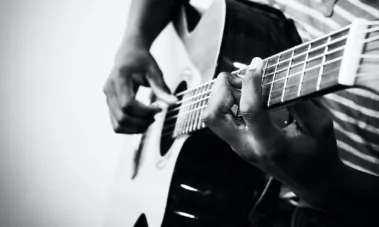
- 1. Take Me Home, Country Roads (1971)
- 2. I'm Yours (2008)
- 3. Brown Eyed Girl (1967)
- 4. Hey There Delilah (2006)
- 5. House of the Rising Sun (1964)
- 6. Fast Car (1988)
- 7. Wish You Were Here (1975)
- 8. Ring of Fire (1963)
- 9. Good Riddance (1997)
- 10. Horse with No Name (1971)
- 11. Drive (2000)
- 12. Banana Pancakes (2005)
- 13. The Joker (1973)
- 14. Blackbird (1968)
- 15. Knocking on Heaven’s Door (1973)
- 16. Fire and Rain (1970)
- 17. Blowin’ in the Wind (1963)
- 18. Tears in Heaven (1992)
- 19. Hallelujah (1984)
- 20. Leaving on a Jet Plane (1966)
Learning guitar is a musical journey that's both gratifying and profound. The beauty of this instrument lies not only in its rich sounds but also in the accessibility of learning to play through guitar tablature. For beginners, tabs act as an easy code to unlock the melodies of countless songs, without the burden of learning to read music. But what exactly is "tablature"?
Tablature is a form of musical notation indicating instrument fingering or the location of the played notes rather than musical pitches.
More specifically, it's a tool that has simplified music learning, making the joy of playing songs on the guitar more accessible. The proof of its value is in trying it yourself. With tabs, what might seem like an intricate art form becomes achievable instantly.
Reading guitar tab is relatively easy to get started with. It uses six horizontal lines to represent the strings of the guitar, with the top line displaying the highest pitched string. Numbers placed on these lines correspond to frets on the guitar neck, directing you where to place your fingers. The easiest way to learn is to jump in. The following 20 songs are great classics songs spanning over 50 years, each with easy acoustic guitar tabs for you try for yourself.
1. Take Me Home, Country Roads (1971)
by John Denver
"Take Me Home, Country Roads" is one of the most beloved acoustic songs of all time, and a great place to start on your easy acoustic guitar tabs journey. Its release in 1971 resonated with a society yearning for simplicity and a return to roots during a time of social and political upheaval. The song's appeal lies in its evocative imagery and warm, uplifting melody, which Denver delivers with heartfelt sincerity. An interesting fact is that initially, Denver was not a writer on the song, but his contributions were significant enough that he was added as a co-writer. Today, it stands as an anthem for West Virginia and remains a popular easy acoustic guitar tab for guitarists due to its singable chorus and easy-to-play chord progression, making it a campfire favorite.
G Em D D C
e|------------------2--2-----2-----|
B|--0--0----0--0----3--3-----3--1--|
G|--0--0----0--0----2--2-----2--0--|
D|--0--0----2--2----------------2--|
A|--2--2----2--3----------------3--|
E|--3--3---------------------------|
2. I'm Yours (2008)
by Jason Mraz
Next up is a more modern tune with a laid-back vibe and catchy melody, that you should be able to pick up in no time.
"I'm Yours" by Jason Mraz is a quintessential sing-along song that brings a smile to listeners' faces with its laid-back vibe and catchy melody. Released in 2008, it quickly became a global hit, encapsulating a message of love and reassurance that resonated deeply with an international audience. The song's conception, according to Mraz, was as spontaneous and organic as the tune itself, which adds to its charm.
The cultural backdrop of the mid-2000s, with its burgeoning social media and digital communication, was ripe for a song that encouraged personal connection and living in the moment. "I'm Yours" did just that, with its simple ukulele chords and Mraz's soothing voice. It remains a popular choice for guitarists due to its playful rhythm and approachable chord progression, making it as fun to play as it is to listen to.
e|--7--7--||--2--2--||--11--11--||--10--10--| B|--7--7--||--2--2--||--12--12--||--10--10--| G|--8--8--||--3--3--||--13--13--||--11--11--| D|--9--9--||--4--4--||--13--13--||--12--12--| A|--9--9--||--4--4--||--11--11--||--12--12--| E|--7--7--||--2--2--||--11--11--||--10--10--|
3. Brown Eyed Girl (1967)
by Van Morrison
"Brown Eyed Girl," released at the peak of Van Morrison's early solo career, is an iconic track that every acoustic guitarist must know! Its upbeat tempo and joyful lyrics evoke a nostalgia that resonates with listeners of all ages. The song was a standout hit from Morrison's album "Blowin' Your Mind!" and has since become a cultural mainstay, signifying youthful romance and the carefree spirit of the 60s.
Despite its light-hearted vibe, "Brown Eyed Girl" initially faced censorship challenges due to its suggestive content. Nevertheless, it established Morrison as a major player in the rock genre. For guitarists, the song is a delight to play, featuring a simple chord progression that encapsulates the essence of rock's golden era. It's a song that brings people together, making it a timeless addition to any musician's repertoire.
Verse:
(G) (C) (G) (D)
e|--3--3----0--0----3--3-----2--2--|
B|--3--3----1--1----3--3-----3--3--|
G|--0--0----0--0----0--0-----2--2--|
D|--0--0----2--2----0--0-----0--0--|
A|--2--2----3--3----2--2-----0--0--|
E|--3--3----x--x----3--3-----x--x--|
Chorus:
(C) (D7) (G) (Em) (C) (D7) (G)
e|--0--0----2--2----3--3----0--0--||--0--0----2--2----3--3--|
B|--1--1----1--1----3--3----0--0--||--1--1----1--1----3--3--|
G|--0--0----2--2----0--0----0--0--||--0--0----2--2----0--0--|
D|--2--2----0--0----0--0----2--2--||--2--2----0--0----0--0--|
A|--3--3----0--0----2--2----2--2--||--3--3----0--0----2--2--|
E|--x--x----x--x----3--3----0--0--||--x--x----x--x----3--3--|
4. Hey There Delilah (2006)
by Plain White T's
With its tender narrative and intimate acoustic arrangement, "Hey There Delilah" by the Plain White T's became a standout track in the mid-2000s. It narrates a long-distance love story, something quite relatable in an era when online relationships were blossoming. The song, featured on their album "All That We Needed," soared in popularity after being re-released in 2006. A fun fact is that Delilah is a real person—a New York City college student and athlete whom the songwriter, Tom Higgenson, met once and was smitten by. The song captured the essence of yearning and devotion, echoing the sentiments of many during a time when technology was making the world smaller, yet often leaving hearts further apart. Its enduring appeal lies in its simplicity and emotional depth, making it an excellent piece for acoustic guitar players looking for easy acoustic guitar tabs to learn for storytelling and melodic charm.
e|-----0-------0-------0-------0---| B|---3---3---3---3---3---3---3---3-| G|-2-------0-------0-------0-------| D|---------------------------------| A|---------------------------------| E|---------------------------------|
5. House of the Rising Sun (1964)
by The Animals
The release of "House of the Rising Sun" by The Animals in 1964 provided the counterculture of the 60s with an anthem that felt both traditional and rebellious. Its exact origins are unknown, but this version's haunting arrangement gave it new life. The song tells a story of downfall and regret in New Orleans, and The Animals' frontman Eric Burdon's soulful delivery made it an instant classic. This was a time when rock was finding its political edge, and "House of the Rising Sun," with its dark narrative set against an arpeggiated guitar pattern, was the perfect soundtrack.
The song's impact was amplified by its ambiguity – the 'Rising Sun' has been interpreted as a brothel, a prison, or a gambling den. This ambiguity has kept the song relevant, as listeners find their own meaning in its lyrics. It's a piece that guitarists often learn early due to its simple yet expressive chord progression, which teaches the importance of dynamics and emotion in performance.
e|-----0-------3-------2-------0-------0-------0-------| B|-----1-------0-------1-------1-------1-------0-------| G|-----2-------0-------2-------2-------0-------0-------| D|-----2-------0-------3-------2-------2-------0-------| A|-----0-------2-------3-------0-------3-------2-------| E|-------------3-------1-----------------------3-------|
6. Fast Car (1988)
by Tracy Chapman
"Fast Car" is a classic hit by Tracy Chapman that narrates a story of hope and aspiration amidst the struggle of life. Released in 1988 on her self-titled debut album, it's a song that combines a folk-rock style with introspective lyrics. The song's storytelling and melodic acoustic guitar line were a stark contrast to the synth-pop that dominated the '80s music scene, offering a raw and authentic narrative that resonated with many.
The song became a symbol of the desire for a better life, reflecting on themes of escape and the search for significance. At its core, "Fast Car" is a reflection on poverty and dreams deferred, which was particularly poignant during the economic struggles of the late '80s. It spoke to those wishing to break the cycle of hardship and find a path to something more fulfilling.
Chapman's "Fast Car" remains relevant due to its enduring themes and its ability to evoke emotion. For guitar players, it offers a relatively simple yet satisfying fingerpicking pattern that is as enjoyable to learn as it is to play. The repeating riff throughout the song is iconic, making it a great easy acoustic guitar tab for both practice and performance.
Intro/Verse: e|-------0-----------0-----------0-----------0-------| B|-----1---1-------1---1-------1---1-------1---1-----| G|---0-------0---0-------0---2-------2---2-------2---| D|---2-------2---2-------2---3-------3---3-------3---| A|---3-----------3-----------3-----------3-----------| E|---------------------------------------------------|
Chorus: e|-------0-----------0-----------0-----------0-------| B|-----1---1-------1---1-------1---1-------1---1-----| G|---0-------0---0-------0---2-------2---2-------2---| D|---2-------2---2-------2---3-------3---3-------3---| A|---3-----------3-----------3-----------3-----------| E|---------------------------------------------------|
7. Wish You Were Here (1975)
by Pink Floyd
Wish You Were Here stands as one of Pink Floyd's most poignant pieces, encapsulating themes of absence and longing. The song is both a tribute to their estranged band member Syd Barrett and a commentary on the detachment they felt from the music industry. The acoustic guitar's intro sets a somber tone that carries through the song, punctuated by a soulful electric guitar solo that has captivated audiences since its release.
In the progressive rock scene of the mid-70s, Pink Floyd was a giant, and this song, from the album of the same name, remains one of their most celebrated works. Its introspective nature continues to resonate with listeners and musicians alike. Guitarists often turn to "Wish You Were Here" for its expressive and iconic guitar parts, which are satisfying to play and offer a chance to delve into more complex string techniques.
Intro (also used as the verse riff): e|-----------------------------------| B|----0---1---0----------------------| G|--------0-------0----0h2-----------| D|----2---------------------2--------| A|----3-------------------------------| E|-----------------------------------|
Chorus: e|---3-------------------------------| B|---3-------------------------------| G|---0-------------------------------| D|---0-------------------------------| A|---2-------------------------------| E|---3-------------------------------|
8. Ring of Fire (1963)
by Johnny Cash
Johnny Cash's "Ring of Fire" is more than just a love song; it's a narrative of passion with a distinctive sound that blends country with mariachi. Released in 1963 and co-written by June Carter Cash, the song tells of falling into a burning love that consumes all. Its release during an era of social change allowed it to become an anthem for those experiencing the transformative power of love.
The song is not only a staple in the country genre but also stands out for its crossover appeal, thanks in part to its catchy melody and vibrant brass arrangements. For guitar players, "Ring of Fire" is an exciting song to learn and play, offering a mix of rhythmic strumming and the opportunity to delve into Cash's rich musical storytelling.
Guitar Riff: e|----2-------2-------2-------2------| B|----3-------3-------3-------3------| G|----2-------2-------2-------2------| D|----0-------0-------0-------0------| A|-----------------------------------| E|-----------------------------------|
9. Good Riddance (1997)
by Green Day
Despite being an atypical Green Day song, "Good Riddance (Time of Your Life)" became one of the band's most enduring hits. It features on their album "Nimrod" and showcases a more acoustic, reflective style. The song became synonymous with poignant life moments, often played at graduations and farewells. The interesting fact here is that the song's title is somewhat sarcastic, but its message is genuinely reflective, encouraging listeners to embrace the journey of life. Released in the late '90s, a time of significant cultural and technological shifts, the song's introspective nature struck a chord with an audience navigating the uncertainties of the approaching new millennium. Its continued relevance is attributed to its universal message and the simplicity of its melody, making it a staple for guitar players. It's an ideal song for beginners, with an easy-to-learn picking pattern and chord progression that's both satisfying to play and to hear.
Verse: e|---3-------3-------3-------3-------| B|---3-------3-------3-------3-------| G|---0-------0-------0-------0-------| D|---0-------0-------2-------2-------| A|---2-------2-------3-------3-------| E|---3-------3----------------------|
Chorus: e|---3-------3-------3-------3-------| B|---3-------3-------3-------3-------| G|---0-------0-------0-------0-------| D|---2-------2-------2-------2-------| A|---3-------3-------3-------3-------| E|-----------------------------------|
10. Horse with No Name (1971)
by America
"Horse with No Name" by America is a classic that became known for its distinctive two-chord riff and surreal desert imagery. Released in 1971, it became a symbol of the era's counterculture movement, capturing a sense of escapism and the quest for identity. The song's simplicity is deceiving, as its lyrics paint a vivid picture that has intrigued listeners for decades. It's particularly famous for being easy to learn on guitar, making it a go-to for beginners. The song's enduring popularity is not just for its nostalgic value but also for its enigmatic lyrics and the haunting atmosphere it creates, which continues to captivate audiences today.
Guitar Riff: e|----0-------0-------0-------0------| B|----0-------0-------0-------0------| G|----2-------2-------2-------2------| D|----0-------0-------0-------0------| A|----0-------0-------0-------0------| E|-----------------------------------|
11. Drive (2000)
by Incubus </h4>
"Drive" by Incubus offers a sense of calm reflection with its mellow acoustic strumming and thought-provoking lyrics. When it hit the airwaves in 2000, it provided a contrast to the angst and aggression prevalent in much of the rock music of the era. The song's theme centers around taking control of one's own destiny, a concept that resonated with many at the turn of the millennium.
The easy-going rhythm and the melodic hook of "Drive" make it a favorite for acoustic guitar players looking for easy acoustic guitar tabs. It's a song that feels both introspective and uplifting, capturing the introspective mood of the era. For those learning the guitar, it offers a blend of simple strumming and subtle fingerpicking, making it a versatile piece to master.
Verse: e|---0-------0-------0-------0-------| B|---0-------1-------3-------1-------| G|---0-------0-------0-------0-------| D|---2-------2-------0-------2-------| A|---2-------3-------2-------3-------| E|---0-------------------------------|
Chorus: e|---0-------0-------0-------0-------| B|---1-------1-------1-------1-------| G|---0-------0-------0-------0-------| D|---2-------2-------3-------3-------| A|---3-------3-------2-------2-------| E|-----------------------------------|
12. Banana Pancakes (2005)
by Jack Johnson
Jack Johnson's "Banana Pancakes" is a song that makes you want to curl up and enjoy a lazy, rainy morning. This song is from his album "In Between Dreams," which captures the laid-back atmosphere of Johnson's acoustic style. An interesting tidbit is that Johnson was a professional surfer before he became a musician, and this song's relaxed vibe perfectly encapsulates his surfer roots. Released in a time when the world was rapidly accelerating into modernity, "Banana Pancakes" served as a reminder to take a step back and enjoy the simple things in life. The song remains relevant as a symbol of slowing down in today's fast-paced society. It's also an excellent song for guitar beginners due to its simple structure and pleasant melody, making it as enjoyable to play as it is to listen to.
e|---0---0---0---0---| B|---1---1---1---1---| G|---0---0---0---0---| D|---2---2---2---2---| A|---3---3---3---3---| E|-------------------|
13. The Joker (1973)
by Steve Miller Band
The Joker is one of the most iconic easy acoustic guitar tabs, known for its catchy guitar riff and the famous wolf whistle played on slide guitar. Featured on the album of the same name, the song became a number one hit for the band. Its lyrics include a series of playful metaphors and a reference to the band's previous hits, which lent the song a sense of fun and self-awareness that was relatable and entertaining.
The early '70s were a time of great musical diversity, with rock music exploring various subgenres and styles. "The Joker" stood out with its blend of rock, funk, and blues, capturing the carefree spirit of the time. It appealed to a wide audience with its easy groove and humorous lyrics, becoming a staple of classic rock stations.
For guitarists, the song is fun to play and instantly recognizable, making it a great addition to any cover band's set list. It's also relatively straightforward to learn, making it accessible for players of various skill levels.
Guitar Riff: e|-----------------------------------| B|-----------------------------------| G|----2-----2----------------2-------| D|--------2-----2---4----2-------4---| A|----0-----0----------0-------------| E|-----------------------------------|
Verse: e|-----------------------------------| B|-----------------------------------| G|-----------------------------------| D|----2----2----2----2----2----2----| A|----2----2----2----2----2----2----| E|----0----0----0----0----0----0----|
14. Blackbird (1968)
by The Beatles
"Blackbird" is a testament to The Beatles' influence on music and culture, and one of the most memorable easy acoustic guitar tabs. Released on their 1968 "White Album," the song is a poignant reflection on the civil rights movement, inspired by the struggle for racial equality. McCartney's fingerpicking pattern, influenced by Bach, is both melodic and rhythmic, presenting a challenge to guitarists that is as enjoyable to learn as it is to master.
At a time of significant societal upheaval, "Blackbird" was a call to action, encouraging listeners to aspire toward change. Its enduring appeal lies in its simplicity and depth, making it a favorite for musicians and a staple of McCartney's solo performances. Learning "Blackbird" is more than learning a song; it's a lesson in musical history and the power of songwriting to effect change.
Verse/Chorus: e|---0-------3-------|---0-------1-------|---0-------0-------|---3-------1-------| B|---1-------0-------|---1-------0-------|---1-------1-------|---0-------0-------| G|---0-------0-------|---0-------0-------|---0-------0-------|---0-------0-------| D|---0-------0-------|---2-------2-------|---3-------3-------|---0-------0-------| A|---2-------2-------|---3-------3-------|---2-------x-------|---2-------x-------| E|---3-------x-------|---x-------x-------|---x-------2-------|---x-------3-------|
15. Knocking on Heaven’s Door (1973)
by Bob Dylan
"Knocking on Heaven’s Door" by Bob Dylan is a soul-stirring song that speaks to the human condition with its simple yet profound lyrics. Written for the soundtrack of the film "Pat Garrett and Billy the Kid" in 1973, it reflects on mortality and the metaphorical knocking on the door between life and the hereafter. Its release during a time of political and social turmoil gave the song a poignant resonance.
With a minimalistic guitar pattern, "Knocking on Heaven’s Door" allows for a focus on the emotive delivery of the lyrics. It's a song that has been covered by a diverse range of artists, a testament to its universal appeal. For those learning this easy acoustic guitar tab, it presents an accessible entry point into Dylan's rich songwriting legacy, as well as the broader folk and rock canon.
Verse: e|----------------|----------------|----------------|----------------| B|----1-----------|----1-----------|----1-----------|----1-----------| G|----0-----------|----0-----------|----0-----------|----0-----------| D|----2-----------|----2-----------|----2-----------|----2-----------| A|----3-----------|----3-----------|----3-----------|----3-----------| E|----------------|----------------|----------------|----------------|
Chorus: e|----------------|----------------|----------------|----------------| B|----1-----------|----1-----------|----1-----------|----1-----------| G|----0-----------|----0-----------|----0-----------|----0-----------| D|----0-----------|----0-----------|----0-----------|----0-----------| A|----2-----------|----2-----------|----2-----------|----2-----------| E|----3-----------|----3-----------|----3-----------|----3-----------|
16. Fire and Rain (1970)
by James Taylor
James Taylor's "Fire and Rain" is a deeply personal song that reflects on the themes of loss and redemption. Released in 1970, the song was an immediate hit, resonating with listeners through its introspective lyrics and Taylor's gentle melodic guitar. It chronicles Taylor's experiences with mental health and the sudden loss of a friend, speaking to the fragility and resilience of the human spirit.
Learning "Fire and Rain" is a masterclass in fingerstyle guitar and emotional expression. The song's complexity lies in its ability to convey a profound narrative through a delicate acoustic performance. Its lasting popularity ensures that it remains a significant and meaningful piece for guitarists to add to their repertoire, embodying the healing power of music.
Verse: e|----------------|----------------|----------------|----------------| B|----------------|----------------|----1-----------|----1-----------| G|----0-----------|----0-----------|----2-----------|----2-----------| D|----2-----------|----2-----------|----3-----------|----3-----------| A|----3-----------|----3-----------|----------------|----------------| E|----------------|----------------|----------------|----------------|
Chorus: e|----------------|----------------|----------------|----------------| B|----1-----------|----1-----------|----------------|----------------| G|----0-----------|----0-----------|----0-----------|----0-----------| D|----2-----------|----2-----------|----2-----------|----2-----------| A|----3-----------|----3-----------|----3-----------|----3-----------| E|----------------|----------------|----------------|----------------|
17. Blowin’ in the Wind (1963)
by Bob Dylan
Bob Dylan's "Blowin’ in the Wind" emerged as a poignant and powerful anthem, becoming one of the most significant protest songs of the 1960s. It's a great easy acoustic guitar tab to have in your repertoire. Released in 1963, its questioning lyrics challenged listeners to consider issues of peace, freedom, and justice, which were highly relevant during the civil rights movement and the escalating conflict in Vietnam.
The song's melody is deceptively simple, yet it carries a weight that resonates through its lyrical inquiry. It has been covered by countless artists and remains a touchstone for social movements. Learning to play "Blowin’ in the Wind" is not only an exercise in musicality but also in historical context, offering guitarists a connection to a pivotal moment in American history.
Verse: e|---0-------0-------0-------0-------| B|---1-------1-------1-------1-------| G|---0-------0-------0-------0-------| D|---2-------2-------2-------2-------| A|---3-------3-------3-------3-------| E|-----------------------------------|
Chorus: e|---0-------0-------0-------0-------| B|---1-------1-------1-------1-------| G|---0-------0-------0-------0-------| D|---2-------2-------2-------2-------| A|---3-------3-------3-------3-------| E|-----------------------------------|
18. Tears in Heaven (1992)
by Eric Clapton
"Tears in Heaven" is a profoundly moving ballad by Eric Clapton that touches the soul with its heartfelt lyrics and delicate melody. Clapton wrote this song after the tragic loss of his four-year-old son Conor, which gives the song its deep emotional resonance. The track appeared on the soundtrack for the film "Rush" and later on Clapton's "Unplugged" album. It showcases Clapton's masterful acoustic guitar work and his ability to convey profound grief and hope through music.
At the time of its release, "Tears in Heaven" was a therapeutic expression for Clapton and many others facing personal tragedies. The early 90s were a period of introspection in popular music, with artists exploring more personal and vulnerable themes. This song, with its narrative of loss and questioning the afterlife, offered a form of solace and connection to listeners around the world.
Today, the song remains a touching piece that transcends time, often played at memorials and reflective events. Learning to play "Tears in Heaven" is not just an exercise in fingerstyle technique, but also a lesson in conveying emotion through music. Its intricate picking pattern and chord structure make it a rewarding challenge for intermediate guitar players.
Verse: e|-------3-----------3-----------3-----------3-------| B|-----3---3-------3---3-------3---3-------3---3-----| G|---0-------0---0-------0---0-------0---0-------0---| D|---------------------------------------------------| A|---------------------------------------------------| E|---------------------------------------------------|
Chorus: e|-------3-----------3-----------3-----------3-------| B|-----1---1-------1---1-------1---1-------1---1-----| G|---0-------0---0-------0---0-------0---0-------0---| D|---------------------------------------------------| A|---------------------------------------------------| E|---------------------------------------------------|
19. Hallelujah (1984)
by Leonard Cohen
Leonard Cohen's "Hallelujah" is a song that has achieved legendary status through its numerous renditions, most notably the haunting version by Jeff Buckley released in 1994. Cohen's original appeared on his album "Various Positions" and has since become one of his most famous works. The song's complex and enigmatic lyrics are open to interpretation, with Cohen himself changing verses in live performances. It's a meditation on love, loss, faith, and redemption that has become a cultural touchstone.
At its release, "Hallelujah" was a departure from the pop and rock sounds that filled the airwaves. Its layered narrative structure and biblical allusions offer a deep well of meaning that listeners have plumbed for decades. Buckley's version, in particular, brought a new level of emotional depth and artistry to the song, making it a perennial favorite.
For guitar players, "Hallelujah" is compelling due to its beautiful, melancholic melody and the emotional power it commands. It's a song that allows for expression through its dynamic range and has become a staple in the repertoire of guitarists around the world for its poignant beauty.
Verse: e|---0---0---0---0---| B|---1---1---1---1---| G|---0---0---0---0---| D|---2---2---2---2---| A|---3---3---3---3---| E|-------------------|
Chorus: e|---0---0---0---0---| B|---1---1---1---1---| G|---0---0---0---0---| D|---0---0---0---0---| A|---2---2---2---2---| E|---3---3---3---3---|
20. Leaving on a Jet Plane (1966)
by John Denver
John Denver's "Leaving on a Jet Plane" encapsulates the bittersweet feelings of farewell and the hope of return. Released in 1966, it became widely recognized after Peter, Paul, and Mary's cover version topped the charts. The song, filled with Denver's signature earnestness, resonates with anyone who has ever faced a goodbye.
Its easy-to-follow chord progression and memorable chorus have made "Leaving on a Jet Plane" a favorite among guitarists of all skill levels. As a folk classic, it offers a piece of Denver's poetic contemplation on travel and separation, themes that are universally relatable. Learning this song allows guitarists to explore the emotional depth that can be conveyed through simple melodies and heartfelt lyrics.
Verse: e|---0-------0-------0-------0-------| B|---1-------1-------1-------1-------| G|---0-------0-------0-------0-------| D|---2-------2-------2-------2-------| A|---3-------3-------3-------3-------| E|-----------------------------------|
Chorus: e|---0-------0-------0-------0-------| B|---1-------1-------1-------1-------| G|---0-------0-------0-------0-------| D|---2-------2-------2-------2-------| A|---0-------0-------0-------0-------| E|-----------------------------------|
Guitar tabs are more than just musical shorthand; they're the bridge to help make your ambition a reality. They simplify the intricate language of music into a straightforward, finger-placed roadmap, allowing you to unlock the rich tapestry of songs that the guitar has to offer. Whether you've just picked up the guitar or are revisiting an old friend, tabs empower you to bring melodies to life with ease and confidence. So take your time and enjoy learning these 20 classic songs, They're great to know as an acoustic guitarist, and will help you step into the ever-expanding world of easy acoustic guitar tabs.






Leave a Reply!